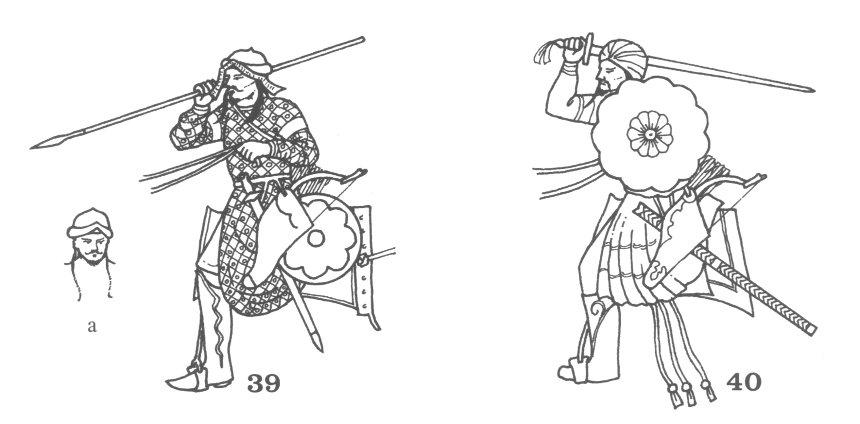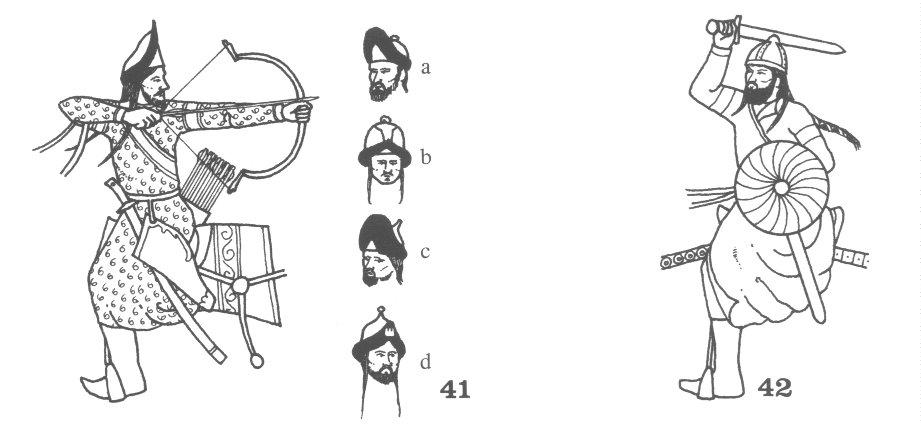39, 40, 41 & 42. TURKISH CAVALRYMEN
Contemporary Christian chroniclers generally used the term 'Turk' to describe Seljuks, Turcomans and Syrians or armies comprised mainly thereof -
Saladin's armies, for example, are described as Turkish even though they also contained many Bedouins, Kurds, Negroes and others.
Of these four figures two are Syrians (41, from the Jazira, a region of Northern Syria round Mosul,
Raqqa and Diyar Bekr, and 42, from Raqqa) and two are Seljuks (39, from a Persian ceramic, and 40, from Azerbaijan;
these are typical of Seljuk warriors in general, figures identical to 39 appearing on Seljuk painted bowls as early as the 11th century).
All 4 wear longish topcoats with a right-over left flap (the Muqallab) at the front, plus embroidered hems, cuffs and collar;
round the upper arms are the usual Tiraz bands.
Tall, loose boots, baggy trousers and, in the case of 39, a small cap with a turban wrapped round it, complete the costume;
39a shows the same type of turban but without the embroidered, trailing headband.
Turbans proper such as that of 40 (who dates to c. 1200) were also being worn at least as early as the late-11th century.
41 wears instead a fur-trimmed hat which bears a striking resemblance to the mitre-caps of 18th century grenadiers and was characterised by a metal plate above the forehead.
This stiff, triangular type of hat, called by the name Sharbush, was of Turkish origin and seems to have been worn only by amirs and chieftains as an indication of rank,
even Saladin being recorded to have worn one (concealing a mail cap beneath).
It was worn under both the Ayyubid and Bahriyyah dynasties but was later abolished by the Circassian Mamluks.
It appears in illustrations only from the late-12th century but had probably been in use somewhat earlier,
the illustrations themselves being principally of Rumi, Jaziran, Iraqi and Azerbaijani origin.
As can he seen here and in other illustrations the Seljuk and Syrian Turks generally (though by no means exclusively -
see 49 and 50)
wore their hair very long in 3 tails, one at each side of the head and one at the back.
Moustaches were usually long (Alp Arslan could allegedly tie the ends of his behind his head!) while beards could be full, short or very wispy,
sometimes comprising no more than a 'shadow' on either side of the jaw and a small tuft under the bottom lip.
As for arms, the Itinerarium Regis Ricardi, describing Saladin's largely Syrian army at Arsouf in 1191,
records that 'the Turks are . . . almost weaponless, carrying only a bow, a mace furnished with sharp teeth, a sword, a lance of reed with an iron tip, and a lightly hung knife'.
Some Turks carried in addition a small axe suspended from the saddle.
The short but powerful composite bow was their principal weapon.
The arrows were light, limiting their penetration somewhat so that although they could pierce armour they often did not and
when they did might inflict only a shallow wound or no wound at all (see page 37).
The bow was often slung behind the left shoulder during close combat.
The bowcase, which could double as a quiver, hung on the left, while the quiver was suspended from the belt at the right; these are occasionally depicted the other way round.
Quivers could contain up to 60 arrows.
In addition spare bows and extra quivers were often carried, sometimes as many as 3 of each, so it was quite feasible for well over 100 arrows to be carried.
The light lance could be used for thrusting or throwing, but javelins might also be carried.
Small shields held by a single, central grip were in general use, that of 40 being of a rather unusual design;
the rose painted at the centre may very well he an heraldic device.
Swords could he curved like that of
47,
long like that of 40, or short and straight.
From its length and shape that of 42 is quite definitely an Indian weapon, Indian swords still being held in high esteem throughout the Moslem world during this era,
just as they had been since as early as the 7th century.
Whether this was because Indian swords were particularly good or because Egypto-Syrian swords were particularly had is not altogether clear.
Certainly al-Tartusi reckoned Egyptian blades as inferior not only to Indian swords but also to Andalusian, Maghribi and Chinese swords too.
Whatever the reason, Indian blades, either of the traditional type shown here or of more 'modern' design,
were imported into the Moslem world in great numbers, often then being rehilted and decorated according to local taste and prevailing fashion.
Captured Frankish swords also feature and underwent similar adaptation.
Other equipment imported from India included lances and corselets (type unspecified but probably scale and/or lamellar).
Turkish clothes were often of brocade or silk and were very bright, usually involving geometric patterns or floral or arabesque motifs on a bright base colour.
|



